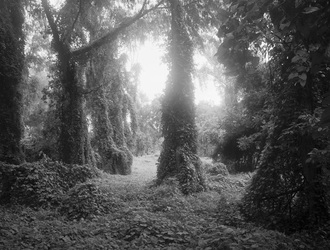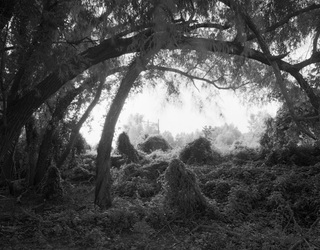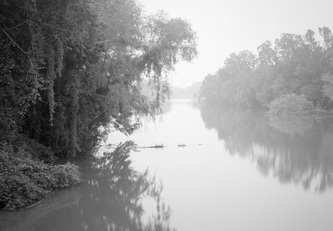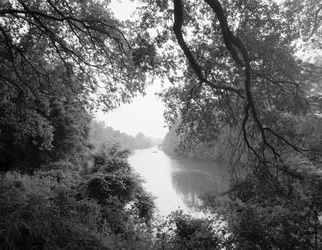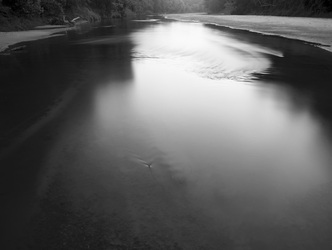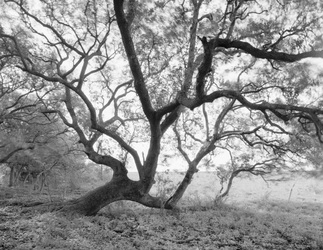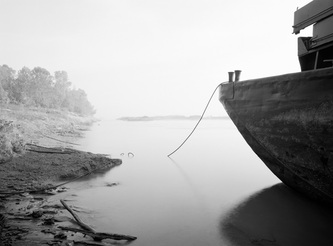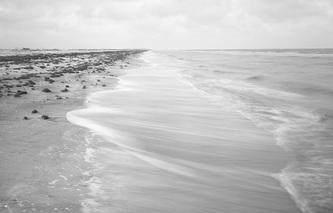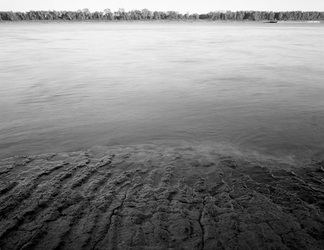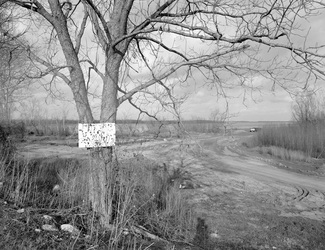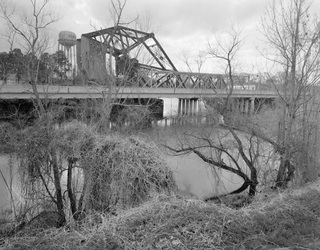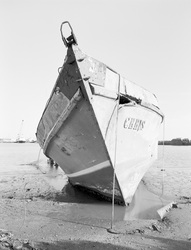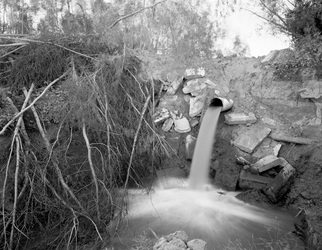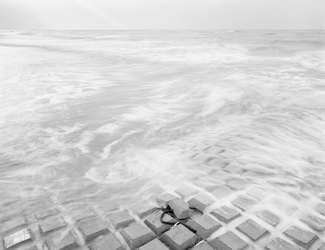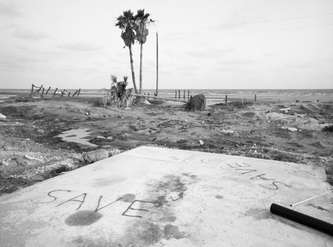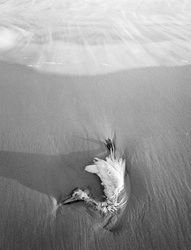OBSERVATIONS OF RESILIENCE: SOUTHERN LOUISIANA LANDSCAPES
Master of Fine Arts Thesis
Louisiana State University
Darren P. Clark
August 1999
OBSERVATIONS OF RESILIENCE
“The beautiful places to which we journey for inspiration surprise us by the melancholy they can induce…that which bothers us about primordial beauty is that it is no longer characteristic. Unspoiled places sadden us because they are, in an important sense, no longer true.” - Robert Adams
I came to Louisiana with preconceived notions of what it would look like. The natural landscape I thought I would find does not exist. It is certainly possible to find massive Live Oak trees draped in Spanish moss, Cypress swamps, and pristine sections of bayous and rivers. These places though, are found in isolated pockets and are no longer the dominating features of the region.
The Geography of Southern Louisiana is shaped by commerce. Every forest has, at least once, been harvested for lumber. The rivers and bayous have been controlled by levees and dredging, in order to discourage flooding and facilitate transportation. The natural levees of the Mississippi River are dominated and polluted by agriculture and the petroleum / chemical industry.
Through investigation of the blemished landscape of Louisiana, I have discovered small, nameless, and often overlooked places. The narrow and hidden strip of land between the Mississippi River and its levee, the intersections between rivers and bayous, gravel pits, and boat launches have been the source of frustration, contentment, and inspiration. These are the places I have chosen to photograph.
I would like to expound upon three specific locations where I have made photographs, which typify my experiences and responses to the Southern Louisiana landscape. One place in particular, which has been the source for personal contemplation and explorations is a bend in the Mississippi River near Baton Rouge known as Duncan Point. I’ve visited this location regularly for three years. The river rises and floods the area annually. A company owns this land and sells the silt deposited by the river. In order to make the land more susceptible to flooding and silt deposition, they clear the trees and dig large pits. Tractors and bulldozers dig the silt, and large trucks haul it to consumers. Between the flooding, the digging, the weather, and the change of seasons, Duncan Point is in a state of constant flux.
In spite of the heat, the humidity, the noise, the mosquitoes, the mud, the dust, and the stench of dying fish, I return often to Duncan Point to experience and observe the changes this place endures. It’s the small things that hold my interest. A broken tree, a makeshift garbage dump, a discarded and decapitated deer carcass, or a burning tire, are examples of objects and events that both intrigue and sadden. On the other hand, things as simple as the emphatic squawk of a heron, new vegetation, or the evening light on the still water of a man-made pond offer hope.
Another area of exploration has been Bayou Lafourche. Bayou Lafourche is a distributary of the Mississippi River. It is also an old channel of the river. In 1921, The Corps of Engineers blocked off the natural channel and now pumps the water into the bayou in order to control flooding as well as to stop the river from changing course. I made naïve assumptions about the landscape and the Mississippi River prior to my arrival. I envisioned a large wild river, and a people who have adapted to the variables of such a place. In truth, it is the landscape, under the insistence of its inhabitants, which has adapted to the people.
The batture of the Mississippi River has also been an area of intrigue. The batture is defined as the inward-facing slope between the crest of the natural levee and the river. The batture of the Mississippi River is a thin strip of land comprised of willows, cottonwoods, and assorted vegetation of natural and exotic origin. It is a linear forest no more than a quarter-mile wide in most places, protect from development by the annual flooding of the river.
Though the batture is protected from permanent development, it is not free from alteration and manipulations. There are marinas, sand and gravel operations, and chemical plants constantly changing this landscape. However, it remains largely a thin strip of wilderness. This linear “wilderness” penetrates cities, farms, and suburbs. From within its depths one is unaware of the inhabited landscape beyond. I have often escaped into its reaches, kicked and sweated through the mud, vines, and garbage, in order to more fully understand this place and develop a relationship with it.
Making photographs in a marred landscape is a troubling prospect. The irreverence with which we treat our landscape is disappointing. However, tires, bulldozed forests, and the haze of pollution are often seductive photographic subjects. This is not because of some implied environmental message, but rather that photography is capable of transforming these sometimes-disagreeable places into objects of intrigue and beauty. I have often wondered (and worried) if I am not glorifying or promoting the destruction and alteration of the landscape that I depict by making beautiful and inviting images of such places. In truth, I hope my photographs advocate an appreciation for the landscape as it is and reveal the strength and resilience of this place and its inhabitants.
The exhibition is about meaning, hope, and beauty found within these altered, damaged, and neglected landscapes. In spite of the impact absorbed by the land, I am hesitantly optimistic. The quality of light, the adaptation and abundance of wildlife, the power of weather, and the resilience of this desecrated land continue to surprise and delight. We need to understand and reconcile ourselves with our surroundings. If a land is not worthy of admiration, how can it be deserving of preservation?
Darren Clark 1999
Master of Fine Arts Thesis
Louisiana State University
Darren P. Clark
August 1999
OBSERVATIONS OF RESILIENCE
“The beautiful places to which we journey for inspiration surprise us by the melancholy they can induce…that which bothers us about primordial beauty is that it is no longer characteristic. Unspoiled places sadden us because they are, in an important sense, no longer true.” - Robert Adams
I came to Louisiana with preconceived notions of what it would look like. The natural landscape I thought I would find does not exist. It is certainly possible to find massive Live Oak trees draped in Spanish moss, Cypress swamps, and pristine sections of bayous and rivers. These places though, are found in isolated pockets and are no longer the dominating features of the region.
The Geography of Southern Louisiana is shaped by commerce. Every forest has, at least once, been harvested for lumber. The rivers and bayous have been controlled by levees and dredging, in order to discourage flooding and facilitate transportation. The natural levees of the Mississippi River are dominated and polluted by agriculture and the petroleum / chemical industry.
Through investigation of the blemished landscape of Louisiana, I have discovered small, nameless, and often overlooked places. The narrow and hidden strip of land between the Mississippi River and its levee, the intersections between rivers and bayous, gravel pits, and boat launches have been the source of frustration, contentment, and inspiration. These are the places I have chosen to photograph.
I would like to expound upon three specific locations where I have made photographs, which typify my experiences and responses to the Southern Louisiana landscape. One place in particular, which has been the source for personal contemplation and explorations is a bend in the Mississippi River near Baton Rouge known as Duncan Point. I’ve visited this location regularly for three years. The river rises and floods the area annually. A company owns this land and sells the silt deposited by the river. In order to make the land more susceptible to flooding and silt deposition, they clear the trees and dig large pits. Tractors and bulldozers dig the silt, and large trucks haul it to consumers. Between the flooding, the digging, the weather, and the change of seasons, Duncan Point is in a state of constant flux.
In spite of the heat, the humidity, the noise, the mosquitoes, the mud, the dust, and the stench of dying fish, I return often to Duncan Point to experience and observe the changes this place endures. It’s the small things that hold my interest. A broken tree, a makeshift garbage dump, a discarded and decapitated deer carcass, or a burning tire, are examples of objects and events that both intrigue and sadden. On the other hand, things as simple as the emphatic squawk of a heron, new vegetation, or the evening light on the still water of a man-made pond offer hope.
Another area of exploration has been Bayou Lafourche. Bayou Lafourche is a distributary of the Mississippi River. It is also an old channel of the river. In 1921, The Corps of Engineers blocked off the natural channel and now pumps the water into the bayou in order to control flooding as well as to stop the river from changing course. I made naïve assumptions about the landscape and the Mississippi River prior to my arrival. I envisioned a large wild river, and a people who have adapted to the variables of such a place. In truth, it is the landscape, under the insistence of its inhabitants, which has adapted to the people.
The batture of the Mississippi River has also been an area of intrigue. The batture is defined as the inward-facing slope between the crest of the natural levee and the river. The batture of the Mississippi River is a thin strip of land comprised of willows, cottonwoods, and assorted vegetation of natural and exotic origin. It is a linear forest no more than a quarter-mile wide in most places, protect from development by the annual flooding of the river.
Though the batture is protected from permanent development, it is not free from alteration and manipulations. There are marinas, sand and gravel operations, and chemical plants constantly changing this landscape. However, it remains largely a thin strip of wilderness. This linear “wilderness” penetrates cities, farms, and suburbs. From within its depths one is unaware of the inhabited landscape beyond. I have often escaped into its reaches, kicked and sweated through the mud, vines, and garbage, in order to more fully understand this place and develop a relationship with it.
Making photographs in a marred landscape is a troubling prospect. The irreverence with which we treat our landscape is disappointing. However, tires, bulldozed forests, and the haze of pollution are often seductive photographic subjects. This is not because of some implied environmental message, but rather that photography is capable of transforming these sometimes-disagreeable places into objects of intrigue and beauty. I have often wondered (and worried) if I am not glorifying or promoting the destruction and alteration of the landscape that I depict by making beautiful and inviting images of such places. In truth, I hope my photographs advocate an appreciation for the landscape as it is and reveal the strength and resilience of this place and its inhabitants.
The exhibition is about meaning, hope, and beauty found within these altered, damaged, and neglected landscapes. In spite of the impact absorbed by the land, I am hesitantly optimistic. The quality of light, the adaptation and abundance of wildlife, the power of weather, and the resilience of this desecrated land continue to surprise and delight. We need to understand and reconcile ourselves with our surroundings. If a land is not worthy of admiration, how can it be deserving of preservation?
Darren Clark 1999
